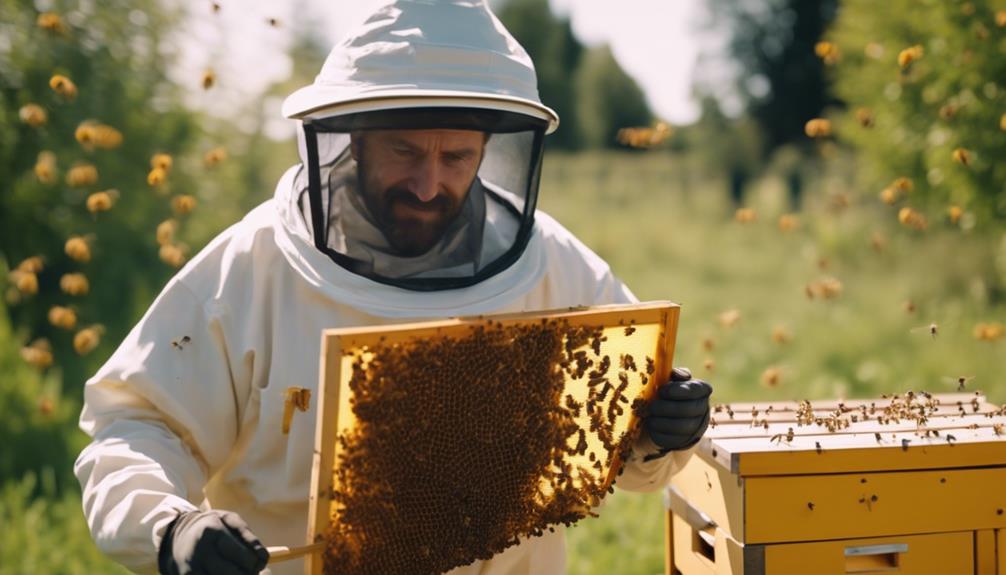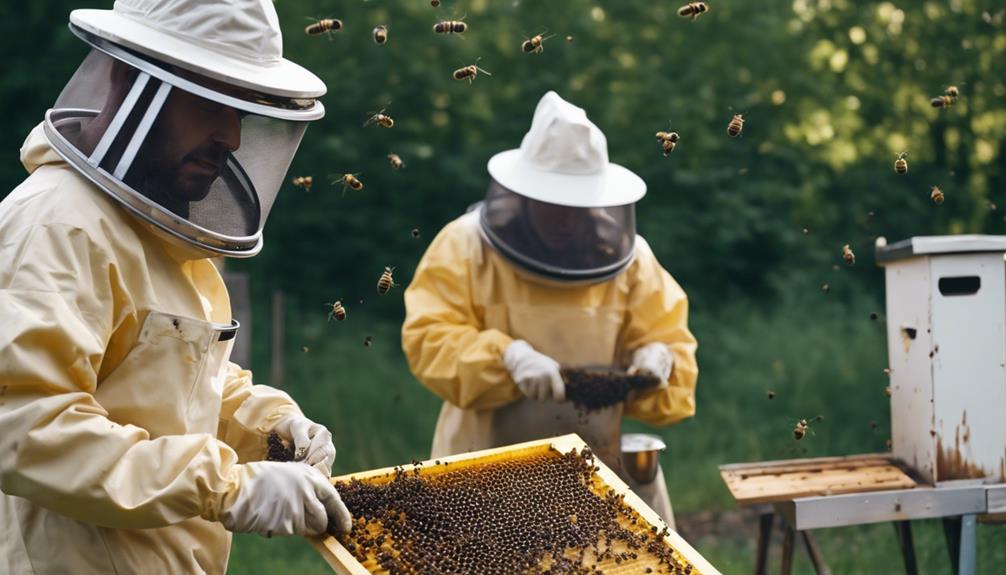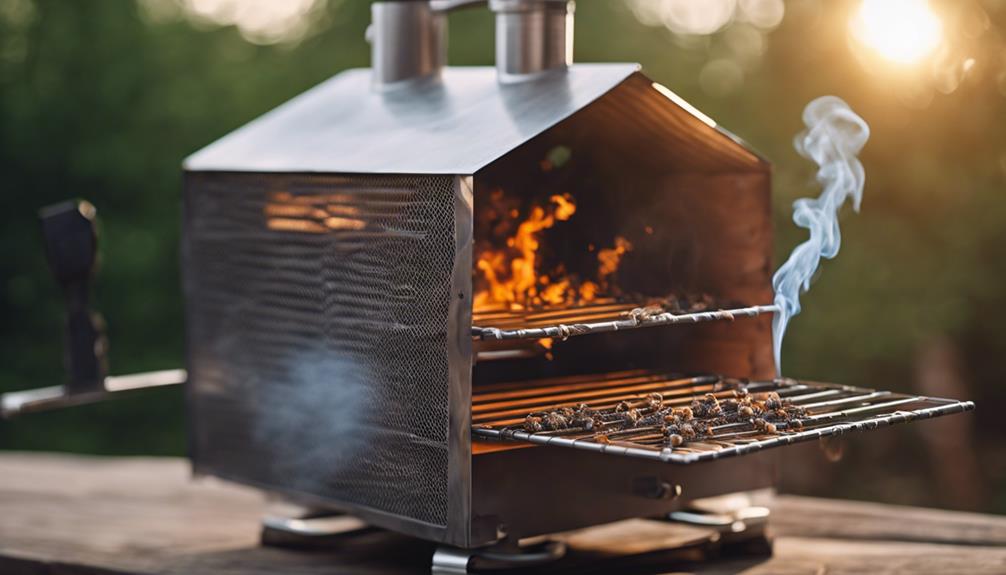Beekeeping can be a fulfilling pastime, but in terms of cost, here’s the honey-coated truth. Initially, setting up can sting a bit, ranging between $400 to $650, including essentials like bees and hives. Ongoing expenses like essential gear and treatments are important too. Don’t buzz off just yet; while it can seem pricey, there are hive-saving strategies to investigate for budget-friendly beekeeping adventures.
Main Points
- Initial costs range from $400 to $650, with package bees or colonies averaging $140 to $200 each.
- Hive acquisition adds $140 to $200 per colony to start beekeeping.
- Additional equipment like bee suits and hive tools are necessary.
- Starting with one hive costs around $500, with additional hives averaging $300 each.
- Cost-saving tips include joining beekeeping groups, exploring DIY options, and bulk purchasing.
Initial Start-Up Costs
Starting beekeeping involves initial start-up costs ranging from $400 to $650, covering essentials such as bees, equipment, and hives.
When diving into this exciting hobby, one can choose between purchasing package bees or nucleus colonies, with costs ranging from $140 to $200 per colony.
Investing in a starter kit with essential supplies is also essential, with prices varying from $200 to $450.
Remember, beekeeping isn’t just about the bees and hives; ongoing expenses like varroa mite treatment and potential hive management costs should also be factored in.
Hive Acquisition Expenses
After covering the initial start-up costs for beekeeping, the next financial consideration lies in the expenses associated with acquiring hives. When it comes to expanding your bee family, you have a few options. A package of bees typically costs between $140 to $175, while a nucleus colony can range from $150 to $200.
It’s important to choose reputable breeders when purchasing bees to guarantee a healthy and productive colony. While catching wild swarms may seem exciting, it comes with risks such as unknown health status and genetics of the bees. These expenses are an integral part of the initial investment in beekeeping, setting the stage for a sweet journey into the world of beekeeping.
Additional Equipment and Supplies
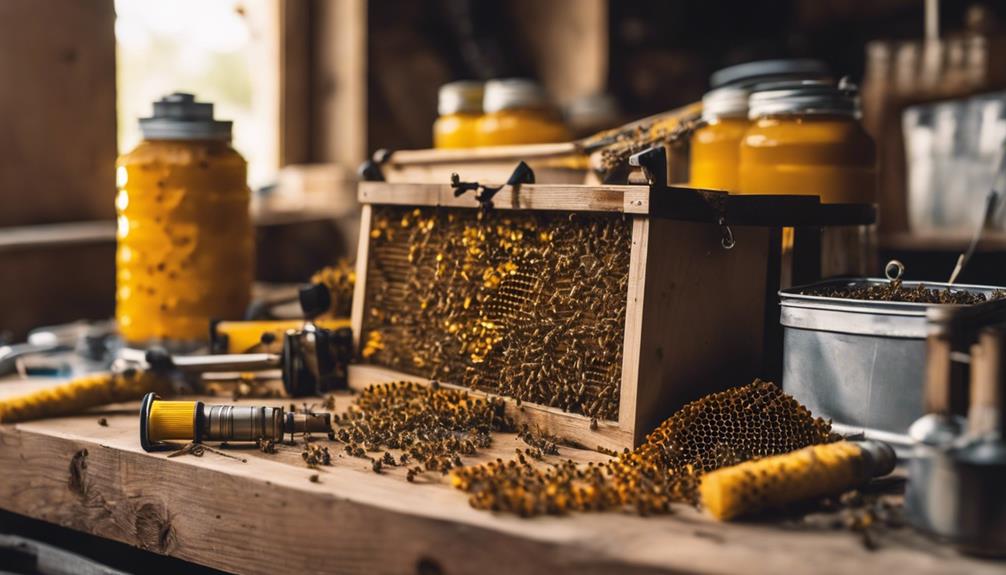
When beekeeping, essential equipment and supplies are crucial for successful maintenance of your hives. This includes bee suits, smokers, hive tools, and bee brushes, which aid in tasks like hive inspections and honey extraction.
To guarantee your bees’ health and productivity, mite treatments are essential to prevent infestations. Consumable supplies such as sugar, smoker fuel, and pollen supplements are also necessary to support your bees’ well-being.
For harvesting honey, extraction equipment like extractors, filters, and jars may be required. Additionally, equipment for hive splits and swarm prevention is essential for effectively managing your bee colonies.
Properly equipping yourself with these tools ensures a smooth and enjoyable beekeeping experience.
Estimated Cost of Starting Beekeeping
To begin beekeeping, one must consider the estimated costs involved in setting up and maintaining a hive. The cost to commence beekeeping typically starts at around $500 for the first hive, with additional hives averaging about $300 each. These estimates can fluctuate based on the types of hives and equipment chosen.
It’s crucial to budget wisely, as starting costs for two hives can range from $700 to $1500. To guarantee financial preparedness for unforeseen expenses, doubling the initial estimates is a prudent strategy. Hive kits, such as Langstroth kits priced at $99.50 or Flow Hive kits at $699, contribute significantly to the overall startup expenses.
Understanding these estimated costs is essential to commencing on a successful beekeeping journey.
Cost-Efficiency Strategies

Considering cost-efficiency strategies in beekeeping involves adopting sustainable practices, leveraging community resources, and prioritizing long-term financial planning. Here are some practical ways to make beekeeping more affordable:
- Engage with local beekeeping groups for shared resources and mentorship.
- Investigate DIY solutions for hive components to reduce costs.
- Collaborate with experienced beekeepers for bulk purchases, lowering expenses collectively.
Sustainable Practices for Savings
When looking to save on beekeeping costs, considering used equipment from retiring beekeepers or creating DIY hive components can be smart moves. These approaches not only help in reducing initial expenses but also promote a sustainable mindset in beekeeping practices.
Cost-Effective Beekeeping Tips
During our beekeeping journey, we’ve found that implementing sustainable practices can significantly reduce expenses and make beekeeping more cost-effective. Here are three tips to help you save money while maintaining thriving hives:
- Reuse Equipment: Consider obtaining gently used hive components from beekeepers exiting the hobby. This not only saves on initial costs but also promotes sustainability by giving equipment a new life.
- DIY Solutions: Investigate building hive bodies and frames yourself. This hands-on approach can be cost-effective and allows for customization to suit your specific beekeeping needs.
- Local Sourcing and Collaboration: Look for cost-effective alternatives by sourcing materials locally or through online platforms. Additionally, collaborating with the local beekeeping community can provide shared resources, tools, and knowledge, enhancing your beekeeping experience economically.
Budget-Friendly Hive Management
To maximize cost-efficiency in beekeeping, implementing sustainable hive management practices is essential. By reusing equipment and constructing DIY hive components, beekeepers can significantly reduce expenses. Collaborating with the local beekeeping community allows for resource sharing, equipment swaps, and knowledge exchange, fostering a cost-effective approach to hive management.
Opting for homemade frames or hive bodies provides budget-friendly alternatives without compromising quality. Prioritizing financial planning through careful budgeting for start-up costs and ongoing expenses is key to overcoming affordability challenges in beekeeping. Additionally, considering purchasing gently used equipment from beekeepers exiting the hobby not only saves money but also aligns with sustainable beekeeping practices.
Embracing these strategies fosters a thriving and financially sustainable beekeeping venture within the local community.
Community Support Benefits
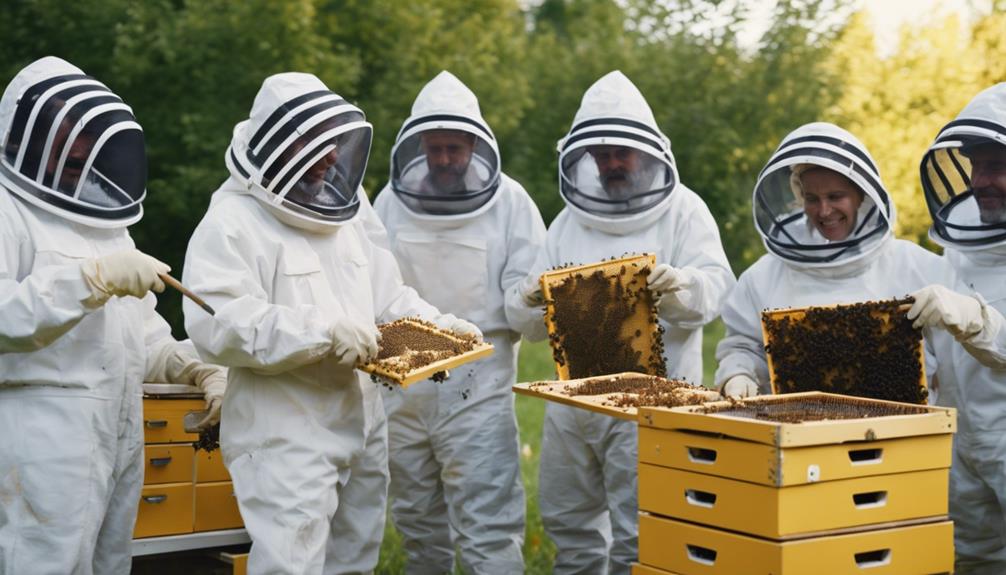
Being part of a beekeeping group provides valuable guidance, mentorship, and shared knowledge within the community. Here are three key benefits of community support in beekeeping:
- Experienced Beekeepers: Seasoned members offer practical advice on hive management and beekeeping techniques, helping newcomers navigate challenges more effectively.
- Group Resources: Access to shared equipment and resources within the community can significantly boost costs and provide innovative solutions to common beekeeping issues.
- Building Relationships: Establishing connections with fellow beekeepers not only enriches learning but also fosters a sustainable and successful beekeeping journey through mutual support and collaboration.
Embracing the community support available can truly enrich your beekeeping experience and set you on the path to becoming a successful beekeeper.
Financial Planning Tips
When considering beekeeping expenses, it’s essential to plan ahead by estimating initial costs and researching ongoing expenses.
By setting a realistic budget and exploring cost-effective options like purchasing used equipment, we can save for necessary items while managing expenses effectively.
Additionally, creating a contingency fund for unexpected costs guarantees financial stability in case of emergencies.
Budgeting for Expenses
Creating a detailed budget is essential for successful beekeeping, as it allows for accurate planning of expenses related to bees, equipment, and ongoing maintenance. When budgeting for beekeeping, consider the following:
- Allocate funds for first-year expenses such as purchasing bees and essential equipment.
- Plan for ongoing expenses like hive maintenance, feeding, and treatments for pests that may arise.
- Factor in long-term expenses for hive expansion, honey extraction equipment, and upgrades to protective gear.
Saving for Equipment
To prepare financially for beekeeping equipment, start by calculating the total cost of necessary supplies like hives, tools, and protective gear. Setting aside a specific monthly amount for savings can help you gradually save up for these essential items.
Research different suppliers to find affordable yet quality beekeeping equipment. Consider buying used gear to save money while still getting what you need.
Creating a budget plan specifically for beekeeping expenses will secure your financial readiness to start this hobby. By saving up and being mindful of costs, you can build up your equipment collection without breaking the bank. Remember, being smart about your purchases can make beekeeping more accessible and enjoyable.

Roger Thomas is a seasoned beekeeper and hive architect with a deep-seated passion for sustainable living. His fascination with bees has shaped his professional career, giving him practical and theoretical expertise in bee behavior, colony health, and optimal hive conditions. Roger’s technical skills shine in his bespoke hive creations that cater to the specific needs of diverse bee species, while his sustainable practices promote environmental balance and the wellbeing of the bee population.
As he continues his journey in beekeeping, Roger has become a dedicated advocate for responsible practices and an insightful educator in his field. His posts aim to inspire new beekeepers, underline the importance of sustainability, and showcase the remarkable contribution bees make to our ecosystem. Roger invites you to join him as he delves into the world of bees and the rewarding, honey-sweet art of beekeeping.
